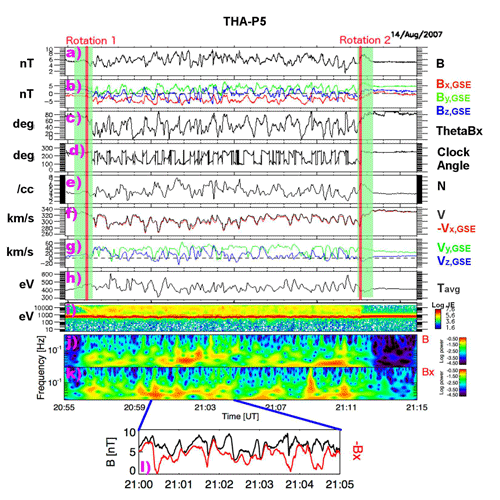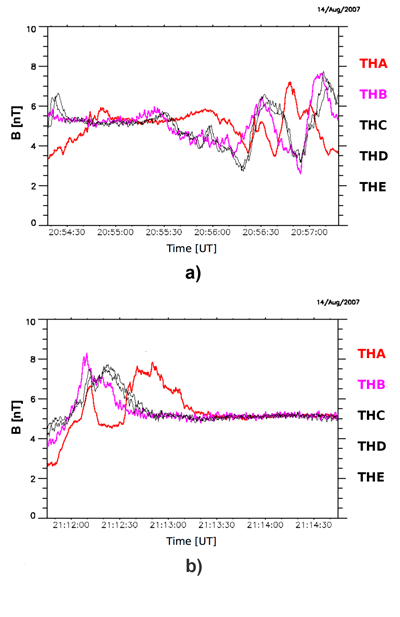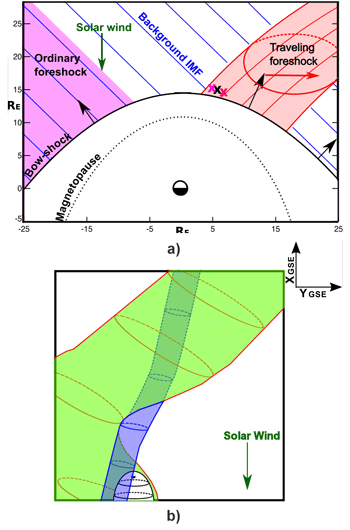
2017 THEMIS SCIENCE NUGGETS
New type of foreshocks at Earth
by Primož Kajdič
Instituto de Geofísica, Universidad Nacional Autónoma de México
Introduction
The solar wind (SW) that flows away from the Sun, encounters obstacles, such as planets and their magnetospheres. Close to them, the SW is decelerated, deflected and heated by the shock waves that stand in front of these obstacles. These shock waves are referred to as bow-shocks and are collisionless in nature.
An important parameter that determines what is observed upstream of the Earth's bow-shock in terms of waves and particles is the angle between the upstream interplanetary magnetic field (IMF) and the local shock normal, θBn. Most of the foreshock phenomena are observed for θBn <45°. The portion of the bow-shock with θBn less (more) than 45° is called quasi-parallel (quasi-perpendicular) shock.
Observations however show backstreaming, field-aligned ion beams (FAB) with energies ≤10 keV for θBn ≤70°. As FABs interact with the incoming SW particles this may result in the growth of ultra-low frequency (ULF) waves with typical periods of 30 seconds. Due to their finite growth time, the ULF waves are not observed together with the FABs but rather together with the so called intermediate ion distributions. The steepend ULF waves are observed closer to the shock together with diffuse ions. The diffuse and intermediate ions exhibit energies up to several hundreds of KeV. All three ion populations are commonly referred to as suprathermal ions. The region upstream of Earth's bow-shock populated by ULF waves (suprathermal ions) is called the ULF wave (suprathermal ion) foreshock (e.g., Eastwood et al. 2005, and references therein).
Omidi et al. (2013) performed global hybrid simulations of planetary bow-shock, under varying upstream conditions. The authors launched two consecutive IMF rotational discontinuities between which the IMF connected to the otherwise quasi-perpendicular bow-shock in such a way that the local θBn was less than 45°. This lead to the development of foreshock-like regions upstream of a portion of the simulated bow-shock between the two IMF discontinuities, that were convected along the bow-shock surface. These regions were called by the authors traveling foreshocks.
Here we use THEMIS and Cluster multi-spacecraft observations to perform case studies of foreshocks and foreshock cavities to confirm the existence of traveling foreshocks.
| Figure 1. THEMIS A data between 20:55 UT and 21:16 UT on 14 August 2007. The two vertical red lines show two IMF RDs and the intervals shadowed in green mark the FCBs at the edges of the traveling foreshock. |
Observations
In 2007 the THEMIS spacecraft formed a string-of-pearls configuration, enabling the study of propagation signatures of structures, such as those of foreshocks. Figure 1 presents THEMIS A observation on 14 August 2007 between 20:56 UT and 21:13 UT. Panel i) shows ion dynamic spectra. We see the onset of suprathermal ions with energies above 20 keV at ~20:56 UT. These ions were observed until ~21:11 UT. Their appearance coincides with compressed ULF waves easily seen on panel a). Thus, during this time interval, the spacecraft was inside a foreshock region. This region is bounded by swift rotations of the IMF which are concurrent with the appearance and disappearance of the ULF waves and suprathermal ions. These rotations occur on time scales of the order of ~1 second and are hence called rotational discontinuities (RD).
| Figure 2. Magnetic field magnitude profiles of the leading (a) and trailing (b) edges of the foreshock detected on 14 August 2007. Red trace represents the THEMIS A data, purple trace the THEMIS B data, while the data of the other three spacecraft are represented by the black traces. |
Figure 2 shows magnetic field profiles of the leading (a) and trailing (b) edges of the foreshock. The red trace represents the THEMIS A data, purple trace the THEMIS B data while the black traces present data from the other three spacecrafts. We see that the first to enter the foreshock was THEMI B, followed by C, D and E spacecraft and THEMIS A was the last to enter it. The same order is observed at the exit from the foreshock.
The fact that the order in which the spacecraft observed this foreshock is the same when they enter and when they exit it tells us that this foreshock swept across the spacecraft, hence we call it a traveling foreshock.
| Figure 3. a) Sketch of the event observed on 14 August 2007 (Fairfield (1971) models for bow-shock and magnetopause have been used here). The purple color represents the global foreshock and the blue lines represent the IMF. The flux tube with different orientation than the background IMF is colored in red. The black arrows are the local bow-shock normals. The red arrow determines the propagation of the traveling foreshock, while the green arrow shows the SW propagation direction. The crosses represent the THEMIS spacecraft locations. b) Due to twisted and braided magnetic field lines the Earth's bow-shock passes through different magnetic flux tubes. Here the bow-shock is first inside the red flux tube, then it passes through a blue tube and returns into the red one. This results in rapid changes in the IMF orientation. As spacecraft cross an interface between two flux tubes they observe a rotational discontinuity. Due to different IMF orientations inside the flux tube, spacecraft observe the convected foreshock signature. |
Figure 3 illustrates the situation in this case. Fairfield (1971) models for bow-shock and magnetopause have been used here. The purple color represents the global foreshock and the red color a flux tube with different orientation than the background IMF (blue lines). The black arrows show the orientation of the local bow-shock normal. The purple, black and red crosses represent THEMIS spacecraft in a configuration similar to the real one. The magnetic flux tubes are carried antisunward (downwards in the Figure) by the solar wind. The intersection of the red flux tube with the bow shock propagates along the YGSE direction. The traveling foreshock also propagates in the same direction (indicated by the red arrow). The local bow-shock geometry changes to quasi-parallel at places where the tube's field lines connect to the bow-shock, so a foreshock region forms upstream of this portion of the bow-shock. This is a traveling foreshock that propagates along the YGSE axis due to the way in which B-field lines in it are oriented. Note that in this Figure the width of the flux tube is smaller than the width of the bow-shock, while in reality it can be larger.
Conclusion
Two different types of foreshock detected upstream of the Earth's bow shock. One is the global foreshock located upstream of quasi-parallel section of the bow-shock. This foreshock may change its location due to IMF rotations. Two succesive IMF rotations may cause the back and forth motion of the foreshock resulting in brief excursions of the spacecraft into it that can last between several tens of minutes to several hours. Another type is the traveling foreshock which exists between two IMF RDs. This kind of foreshock usually lasts of the order of ten minutes in the spacecraft data. We call it a traveling foreshock since it propagates along the bow-shock surface. We should stress out though that when the flux tube is large enough, it can affect the whole bow shock surface so the resulting traveling foreshock will also be "global."
The difference between what is traditionally called the global foreshock and the traveling foreshock is not their size. In the case of back and forth motion of the global foreshock, the orientation of the IMF changes, but the bow-shock remains inside the same flux tube. In case of traveling foreshock the bow-shock (or a portion of it) magnetically connects to different flux tubes.
References
Kajdič, P., Blanco-Cano, X., Omidi, N., Rojas-Castillo, D., Sibeck, D. G., & Billingham, L. (2017). Traveling foreshocks and transient foreshock phenomena. Journal Geophysical Research: Space Physics, 122, 9148–9168, https://doi.org/10.1002/2017JA023901Eastwood, J. P., E. A. Lucek, C. Mazelle, K. Meziane, Y. Narita, J. Pickett, and R. A. Treumann (2005), The Foreshock, Space Sci. Rev., 118(14),4194, doi:10.1007/s11214-005-3824-3. Fairfield, D. H. (1971), Average and unusual locations of the Earth's magnetopause and bow shock, J. Geophys. Res., 76(28), 6700–6716, doi:10.1029/JA076i028p06700.
Omidi, N., D. Sibeck, X. Blanco-Cano, D. Rojas-Castillo, D. Turner, H. Zhang, and P. Kajdič (2013), Dynamics of the foreshock compressional boundary and its connection to foreshock cavities, J. Geophys. Res. Space Physics, 118, 823831, doi:10.1002/jgra.50146.
Biographical Note
Primož Kajdič is a tenure track full time scientist at the Geophysics Institute, Universidad Nacional Autónoma de México. His primary interests are collisionless shocks in the Solar System and the corresponding foreshock regions, magnetosheath jets and space weather at Mars.
 Please send comments/suggestions to
Emmanuel Masongsong / emasongsong @ igpp.ucla.edu
Please send comments/suggestions to
Emmanuel Masongsong / emasongsong @ igpp.ucla.edu



